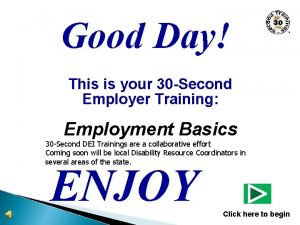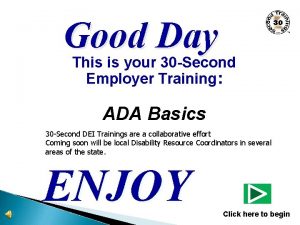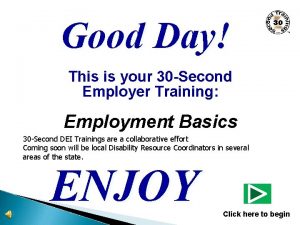Good Day This is your 30 Second Employer






- Slides: 6

Good Day! This is your 30 -Second Employer Training: Employment Basics 30 -Second DEI Trainings are a collaborative effort Coming soon will be local Disability Resource Coordinators in several areas of the state. ENJOY Click here to begin

What are some examples of accommodations that would benefit all of my employees, including both those with and without disabilities? Offering “Flex-Time” and “Job-Share” as options to support the demands of employees’ lifestyles (e. g. family, medical, etc…). Instituting elements of “Universal Design” in the workplace. Providing ergonomic assessments and implementing reasonable accommodations. All of the Above.

True! But there is more… Offering Flex-time and Job-Share costeffective ways in which employers can accommodate their valued employees; talent you might otherwise lose to the competing demands of family and medical needs, travel or professional development opportunities. These strategies have been proven to maximize efficiency and increase productivity in the workforce, while improving the morale of workers and reducing employee turnover. Try Again!

True… The intent of universal design is to simplify life for everyone by making products, communications, and the built environment more usable by as many people as possible at little or no extra cost. Ergonomic keyboard TTY phone Universal design benefits people of all ages and abilities. For more information on universal design click here. Universally Accessible Office Space Please try again for the best answer!

Good idea… Ergonomics commonly refers to designing work environments for maximizing safety and efficiency. Companies once thought that there was a bottom-line tradeoff between safety and efficiency. Now they embrace ergonomics because they have learned that designing a safe work environment can also result in greater efficiency and productivity. Recently, U. S. laws requiring a safe work environment have stimulated great interest in Ergonomics - from ergonomic furniture to ergonomic training. But it is in the design of the workplace as a whole where the greatest impact can be seen for both safety and efficiency. The easier it is to do a job, the more likely it is to see gains in productivity due to greater efficiency. Analogously, the safer it is to do a job, the more likely it is to see gains in productivity due to reduced time off for injury. Ergonomics can address both of these issues concurrently by maximizing the workspace and equipment needed to do a job. Please try again for the best answer!

CORRECT! Incorporating policies and practices such as “Flex-Time”, “Job. Share”, and “Universal Design” into your physical work environment and work culture will increase the efficiency, productivity, and morale of your employees. Any or all of these strategies can be utilized to promote a more accessible and accommodating workplace that attracts and keeps talented workers and reduces employee turnover. To learn more about these practices, take the training again and click on those options, or go to the Job Accommodation Network by clicking here. Thank you From Glenn Olsen your Disability Employment Initiative State Lead Glenn. olsen@dwd. wisconsin. gov











